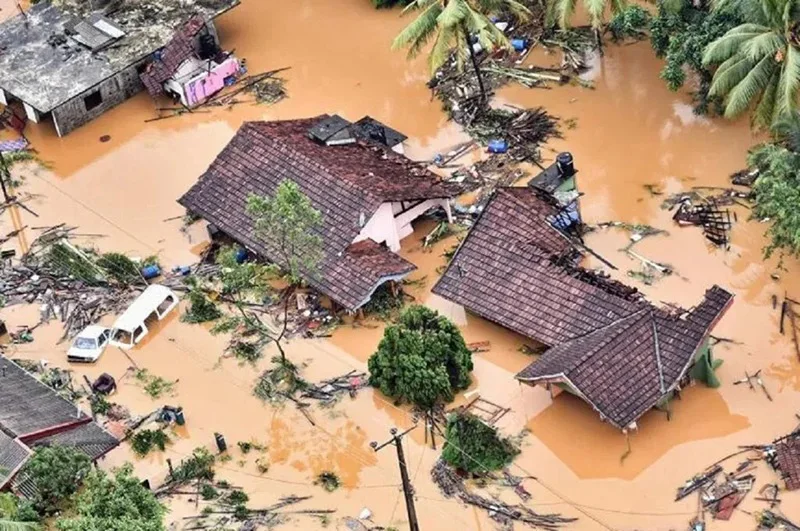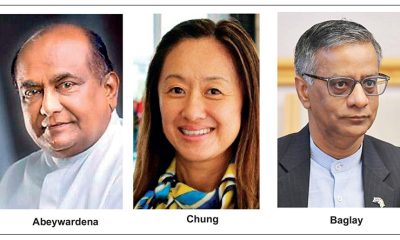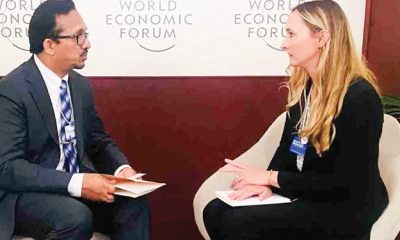Opinion
‘COOL’ debacle in the hands of fools: He laughs best who laughs last! – II

By Rohana R. Wasala
(continued from yesterday)
During the first interview mentioned above, Ali Sabry made the patently false claim that the Aluthgama and Digana incidents drove young Muslims to extremism, whereas the truth was the reverse of that, as borne out by evidence. (These incidents must be investigated even belatedly to discover the factual situation. The disastrous policy of political correctness that led to the submergence of the truth on those occasions then seemed to be at work once again.) Sabry referred to how the UK responded to incidents of Islamic extremist violence as a model to follow in dealing with the same problem in Sri Lanka: the UK government reached out to the mainstream Muslim minority and acted to win their confidence and support in order to contain Islamic extremism in that country. That was a false analogy. He implied that Sri Lanka had to do the same (as if Sri Lanka has not been doing exactly that for centuries). (The violent imagery in his speech was an indication of the commotion in his own mind resulting from his subliminal awareness of guilt as he felt compelled to lie in that situation for political expediency within his own community. His persistent advocacy of burial against the lawful directives of the DGHS revealed his anxiety to avoid displeasing pious Muslims who insisted on burying their dead as per strict Muslim funeral rites.) It was reported that he threatened to resign from his ministerial post on this issue, but that he was persuaded to stay on, which to the genuinely concerned sounded fishy, no doubt.
Ali Sabry had been sounding the warning mentioned above (about possible unrest among Muslim youth over the ‘no burial only cremation’ problem since early April 2020. He apparently believed that he was undergoing a sort of public trial by being blamed by both the Muslim community on the one hand who felt aggrieved by the compulsory cremation rule imposed on all citizens by the health authorities for the safe disposal of bodies of Covid-19 victims and the numerically strong nationalist faction on the other led by the monks, who insisted] that the rule should not be relaxed to satisfy the whims of one particular group of people thereby endangering the lives of the whole population through the possible release of the still inadequately understood novel coronavirus from the interred bodies to the country’s water table, which, in many places in Sri Lanka, is not very deep, and lies close to the surface. The controversial Gnanasara Thera (who is now heading the presidential task force) was an exception: he spoke up for Muslims who wanted to bury; the monk said that the Muslims’ demand for burial should be allowed.
Ali Sabry should know better than most that there has been no lack of reaching out to the mainstream Muslim minority either by the majority community or by the successive governments. Muslims as a community are mainly engaged in business. Seventy-five perscent of their customer base comprises Sinhalese, making it possible for Muslim businesses to thrive normally, though there’s been just condemnation, among the citizenry including the majority Sinhalese, of worsening Islamist extremism in recent years. Be that as it may, it is not simply because Sabry had served president Gotabaya in the past as his implicitly trusted personal legal service provider that he was made a national list MP by the SLPP and honoured and empowered with such a very important key portfolio.
‘One country One law’ was the rallying cry that inspired patriotic Sri Lankans at both the presidential and parliamentary elections to vote for the SLPP, which won with the largest margins. As minister of justice Sabry has been entrusted with the task of supervising the making of a new constitution that is designed to achieve that epoch making change (namely, One Country, One Law) among other things. Gotabaya made no bones about the fact that he won the presidency almost exclusively on the strength of Sinhalese votes, as already hinted above; most Muslims and Tamils chose not to respond positively to his call for support at the presidential election. His bluntness was a reflection of his characteristic candour, which had then not been compromised by the hypocrisy of political correctness, his older brother’s blunt weapon, that fails more often than it succeeds.
But Gotabaya did not hold any grudge against those who rejected him, for in the same breath president elect Gotabaya said that he was elected as president of all the citizens of the country and that he would serve in that post without discriminating against any citizen. There is no doubt about the fact that he meant what he said. By appointing Ali Sabry to the powerful post of Minister of Justice, the president incidentally reassured the Muslims that he would not exclude them from his vision of prosperity and splendour for the nation.
But Ali Sabry did not budge an inch from his original unqualified opposition to the mandatory burning of bodies of Muslim victims of Covid-19 over which he expressed his disappointment in a Facebook post, something mentioned in an Al Jazeera news report/April 3, 2020, with the authorities’ decision which, he alleged, ignored the WHO guidelines that allow both burial and cremation. Were we to believe that our experts chose to overlook the WHO guidelines without a rational explanation? Sabry deliberately ignored the various reservations that clearly qualified the WHO guidelines, leaving the authorised specialists of any member country to modify those recommendations as appropriate for local conditions and ground realities. The basic assumption that he seemed to be operating on, regarding the burial problem, was wrong. For all intents and purposes, he pretended to wrongly believe that the health authorities insisted on making no exception for Muslim dead in this case because that was what the monks wanted. Ali Sabry was the last person that rational people would expect to demand that Muslims should be allowed to bury their loved ones dead from the novel coronavirus while cremation was the only safe method ordered by the Director General of Health Services (DGHS).
This is not a happy thing to say about arguably the most important and influential minister in the cabinet, being the closest companion of the President, next to the Prime Minister, who is the president’s own brother. It was inconceivable how Ali Sabry was capable of (no doubt unintentionally) justifying the berserk behaviour of some virus-infected Muslims (as seen in their show of insubordination, noncooperation, physical harassment of the health workers trying to help them including spitting at them (with the malicious intention of spreading the infection); cases were reported of some Covid-19 positive tested individuals spitting out of the windows of buses carrying them to quarantine centres in vicious attempts to spread dreaded infection). Such demonstration of unprovoked anger is based on the false pretext of alleged discrimination against them by the government in the matter of mandatory cremation of Corona dead as prescribed by the responsible health experts to prevent the escape of the deadly virus with many unknowns into the environment. The virus is no respecter of people’s religious sensitivities. If the Director General of Health determined that cremation was the only option for Sri Lanka in the prevailing emergency, all citizens were obliged to accept that and act accordingly.
Why didn’t Sabry make an effort to explain to the agitating Muslims and to the misinformed Muslim world in general, who have never been enemies of Sri Lanka, that this blown-out-of-proportion controversy over the burial or cremation issue had nothing to do with the monks or the government or the health authorities or the army and police officers (the last mentioned having been co-opted into the Covid containment operation only as ancillary personnel employed for a strictly logistical purpose to serve under the DGHS, the government appointed competent authority, who gives leadership to the whole enterprise, which involves every single citizen of the country).
The cremation imperative was not an arbitrary decision taken by the government to spite the Muslim minority under pressure from the monks as misleadingly suggested by the hostile foreign NGO elements, Islamists, a handful of misguided Muslims, and the irresponsible SJB-led opposition. The DGHS was not acting capriciously either; his recommendations were based on a scientific rationale collectively defined by a group of experts belonging to a number of different but relevant fields of study in the best interest of all resident Sri Lankans and foreign visitors. Ali Sabry seemed to be more concerned about remaining in the good books of the handful of Islamists and their sympathisers than about the feelings of the ninety-five per cent of the population who are against them.
The fate of the goal of One Country One Law under Ali Sabry as Minister of Justice is not difficult to guess.
Concluded
Opinion
Feeling sad and blue?

Here is what you can do!
Comedy and the ability to have a good laugh are what keep us sane. The good news to announce is that there are many British and American comedy shows posted up and available on the internet.
They will bring a few hours of welcome relief from our present doldrums.
Firstly, and in a class of its own, are the many Benny Hill shows. Benny is a British comedian who comes from a circus family, and was brought up in an atmosphere of circus clowning. Each show is carefully polished and rehearsed to get the comedy across and understood successfully. These clips have the most beautiful stage props and settings with suitable, amusing costumes. This is really good comedy for the mature, older viewer.
Benny Hill has produced shows that are “Master-Class” in quality adult entertainment. All his shows are good.
Then comes the “Not the Nine o’clock news” with Rowan Atkinson and his comedy team producing good entertainment suitable for all.
And then comes the “Two Ronnies” – Ronnie Barker and Ronnie Corbett, with their dry sense of humour and wit. Search and you will find other uplifting shows such as Dave Allen, with his monologues and humour.
All these shows have been broadcast in Britain over the last 50 years and are well worth viewing on the Internet.
Similarly, in The USA of America. There are some really great entertainment shows. And never forget Fats Waller in the film “Stormy Weather,” where he was the pianist in the unforgettable, epic, comedy song “Ain’t Misbehavin”. And then there is “Bewitched” with young and glamorous Samantha Stevens and her mother, Endora who can perform magic. It is amazing entertainment! This show, although from the 1970s was a milestone in US light entertainment, along with many more.
And do not overlook Charlie Chaplin and Laurel and Hardy, and all the Disney films. Donald Duck gives us a great wealth of simple comedy.
The US offers you a mountain of comedy and good humour on Youtube. All these shows await you, just by accessing the Internet! The internet channel, ‘You tube’ itself, comes from America! The Americans reach out to you with good, happy things right into your own living room!
Those few people with the ability to understand English have the key to a great- great storehouse of uplifting humour and entertainment. They are rich indeed!
Priyantha Hettige
Opinion
There is much to learn

After the recent disaster, a great deal of information has been circulating on WhatsApp and YouTube regarding our reservoirs, highways, etc.
In many of these discussions, people have analysed what went wrong and how the damage could have been prevented. My question is this: why do all these knowledgeable voices emerge only after disaster strikes? One simple reason may be that our self-proclaimed, all-knowing governing messiahs refuse to listen to anyone outside their circles. It is never too late to learn, but has any government decision-maker read or listened to these suggestions?
When the whole world is offering help to overcome this tragedy, has the government even considered seeking modern forecasting equipment and the essential resources currently not available to our armed forces, police, and disaster-management centres?
B Perera
Opinion
Disasters: Hidden danger

A great deal has been said about Cyclone Ditwah and its impact. To my mind one important aspect of it has not been addressed.
During the 1,400 odd landslides, it washed off a vast volume of soil which entered the various water bodies like tanks, lakes, rivers and streams etc. This process has raised their water levels reducing the water holding capacities (water holding capacity has a different meaning in soil science). What it means is that they cannot hold the same amount of water as before without spilling. Therefore, a precipitation which would not have been significant then can cause spilling of tanks leading to floods now. Hence there is a possibility of experiencing more floods in the future. Due to silting the tanks will carry less water than before, thus reducing the irrigable areas under their command. They will not be able to irrigate the same extents of paddy, thus affecting production.
How do we rectify this situation? It is desilting which can be very expensive.
It is good if these are considered in future planning.
Gamini Peiris
Panadura
Experienced agriculturist
-

 Features7 days ago
Features7 days agoFinally, Mahinda Yapa sets the record straight
-

 Features7 days ago
Features7 days agoHandunnetti and Colonial Shackles of English in Sri Lanka
-

 Business5 days ago
Business5 days agoCabinet approves establishment of two 50 MW wind power stations in Mullikulum, Mannar region
-

 News6 days ago
News6 days agoGota ordered to give court evidence of life threats
-

 Features6 days ago
Features6 days agoCliff and Hank recreate golden era of ‘The Young Ones’
-

 Opinion7 days ago
Opinion7 days agoA national post-cyclone reflection period?
-

 Features6 days ago
Features6 days agoSri Lanka and Global Climate Emergency: Lessons of Cyclone Ditwah
-

 Latest News6 days ago
Latest News6 days agoSri Lanka squad named for ACC Men’s U19 Asia Cup













